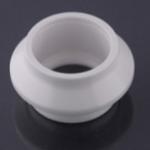Alumina Ceramic Best Material For Industrial Applications With High
Chemical-Resistance
The production of high-performance alumina ceramic involves precise
engineering and controlled processes to achieve desired purity,
density, and microstructure. Key steps include:
Powder Preparation
High-purity Al₂O₃ powder (typically 99.5%+ purity) is synthesized
via Bayer process or chemical precipitation.
Particle size distribution is optimized (submicron to a few
microns) to enhance sintering activity.
Forming Techniques
Dry Pressing: Suitable for simple shapes; powder compacted under high pressure
(50–200 MPa).
Isostatic Pressing (CIP/HIP): Uniform compaction for complex geometries using hydrostatic
pressure.
Injection Molding: For intricate parts; Al₂O₃ powder mixed with binders, molded, and
debound.
Slip Casting: Used for thin-walled components; aqueous slurry poured into
porous molds.
Sintering
Fired at 1500–1800°C (depending on purity) in air or controlled
atmospheres.
Densification occurs via solid-state diffusion, achieving >98%
theoretical density.
Grain growth is managed to balance strength and toughness.
Post-Processing
Precision machining (laser cutting, grinding) for tight tolerances.
Surface treatments (polishing, coating) to enhance functionality.
Advanced variants may involve:
This rigorous process ensures alumina ceramics meet demanding
applications in aerospace, semiconductors, and biomedical fields.






